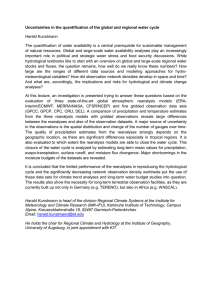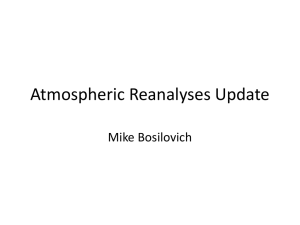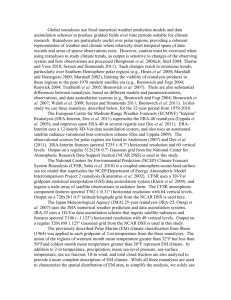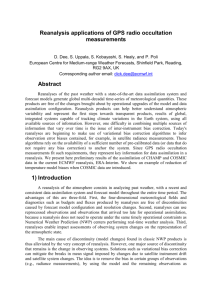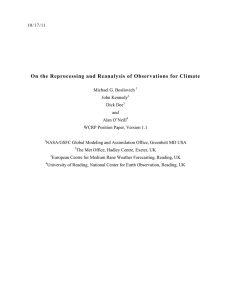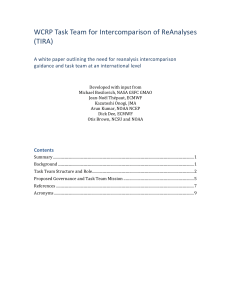ReanalsBaltimore
advertisement
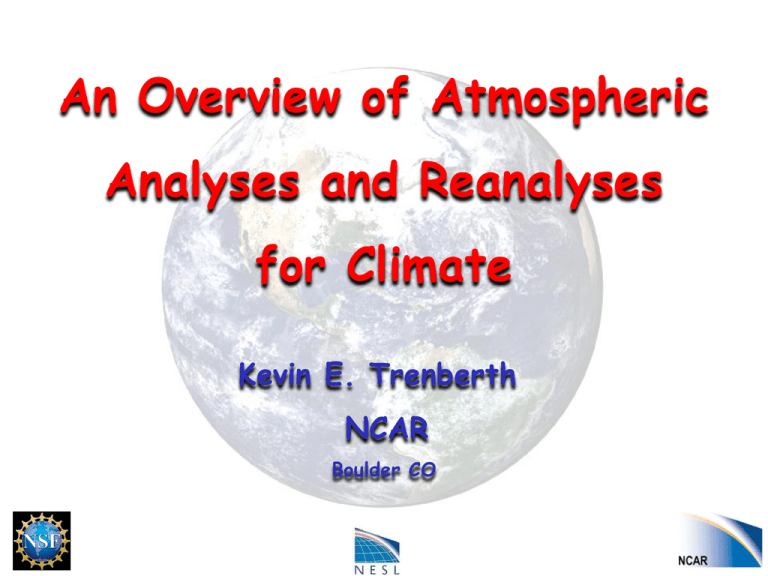
An Overview of Atmospheric Analyses and Reanalyses for Climate Kevin E. Trenberth NCAR Boulder CO Analysis Data Assimilation merges observations & model predictions to provide a superior state estimate. x t dynamics physics x It provides a dynamically- consistent estimate of the state of the system using the best blend of past, current, and perhaps future observations. Obs 4DDA Model Improved products, predictions, understanding Experience mainly in atmosphere; developing in ocean, land surface, sea ice. Data assimilation system The observations are used to correct errors in the short forecast from the previous analysis time. Every 12 hours ECMWF assimilates 7 – 9,000,000 observations to correct the 80,000,000 variables that define the model’s virtual atmosphere. This is done by a careful 4-dimensional interpolation in space and time of the available observations; this operation takes as much computer power as the 10-day forecast. ECMWF 2009 NWP models and data assimilation continues to improve Operational forecast scores of major NWP centers. RMSE of geopotential height at 500hPa in NH (m) for 24-hour forecasts are displayed. The scores of forecasts have improved over time. NWP Forecast skill scores continue to improve Extratropical NH and SH forecasts: 12 month means plotted at last month. Updated from Simmons and Hollingsworth 2002 SH skill became comparable to NH after about 2002! Reanalysis Operational four dimensional data assimilation continually changes as methods and assimilating models improve, creating huge discontinuities in the implied climate record. Reanalysis is the retrospective analysis onto global grids using a multivariate physically consistent approach with a constant analysis system. Reanalysis has been applied to atmospheric data covering the past five decades. Although the resulting products have proven very useful, considerable effort is needed to ensure that reanalysis products are suitable for climate monitoring applications. From: Executive Summary of “The Second Report on the Adequacy of The Global Observing Systems for Climate in Support of the UNFCCC”. 20 Aug 2003 Atmospheric Reanalyses Current atmospheric reanalyses, with the horizontal resolution (latitude; T159 is equivalent to about 0.8 ), the starting and ending dates, the approximate vintage of the model and analysis system, and current status. Reanalysis Horiz.Res Dates Vintage Status NCEP/NCAR R1 T62 1948-present 1995 ongoing NCEP-DOE R2 T62 1979-present 2001 ongoing CFSR (NCEP) T382 1979-present 2009 thru 2009, ongoing C20r (NOAA) T62 1875-2008 2009 Complete, in progress ERA-40 T159 1957-2002 2004 done ERA-Interim T255 1989-present 2009 ongoing JRA-25 T106 1979-present 2006 ongoing JRA-55 T319 1958-2012 2009 underway 1979-present 2009 thru 2010, ongoing MERRA (NASA) 0.5 8 What have we gained and what are the benefits? Prior to reanalyses, the analyzed climate record was beset with major discontinuities from changes in the data assimilation systems. It was difficult, if not impossible, to reliably infer anomalies and to analyze climate variability. The use of a stable data assimilation system has produced fairly reliable records for monitoring, research and improved prediction that have enabled : climatologies to be established anomalies to be reliably established time series, empirical studies and quantitative diagnostics exploration of, improved understanding of processes model initialization and validation test bed for model improvement on all time scales, especially seasonal-to-interannual forecasts Greatly improved basic observations and data bases. What have we learned? Observing system changes affect variability Trends and low frequencies unreliable Exacerbated by model bias Budgets don’t balance Impacts many diagnostic studies Problems with hydrological cycle Sensitivity to model physics (e.g., convection) Exacerbated by insertion of observations Problems with warm season continental climates precipitation diurnal cycle Unrealistic surface fluxes Ocean (radiative, freshwater) Land (precipitation, radiative) Limits usefulness for offline forcing; e.g. ocean modeling Limits ability to do coupled assimilation Quantities/regions not a priority for weather centers Surface Stratosphere Polar regions Many aspects of tropics Reanalysis A MAJOR challenge remains the continually changing observing system in spite of substantial improvements in bias correction in the latest generation of reanalyses 11 Satellite Data Streams assimilated Dec TOVS Feb Jul TIROS-N Apr Sep Nov Oct Feb NOAA-6 NOAA-7 NOAA-8 May Jun Jul Oct Jan Nov NOAA-9 NOAA-10 Dec Sep Nov Jan Sep Sep Sep NOAA-11 NOAA-12 Jun NOAA-14 Jan Dec NOAA-15 Sep ATOVS NOAA-16 Nov NOAA-17 Jul NOAA-18 EOS Aqua EOS Aqua Oct GOES-08 GOES Sounders Apr Jul GOES-10 Apr Jun F08 GOES-12 Jul SSM/I Nov F10 Dec Dec F11 Jul Nov Dec Dec F13 May F14 May F15 Dec Aug 78 79 80 81 82 83 84 85 86 87 88 89 90 91 92 93 94 95 96 97 98 99 00 01 02 03 04 05 06 07 08 Example: Satellite based observations • • • • • • Satellites typically last 3-5 years and have to be replaced Orbits decay Equator crossing times change New satellite orbits differ Instrument calibrations drift and can be changed by launch Interference can occur from other instruments The Changing Observing System 1973 77k/6h 1987 550k 1979– 77K Obs 324k 1973 every 6hrs 2006 4,220k 1987 – 550K Obs every 6hrs 1979 – 325K Obs every 6hrs 2006 – 4.2M Obs every 6hrs Bias corrections are needed But how good are they? Is there a baseline to establish real trends? Bias corrections should be applied to satellite and radiosonde data. Potential for unintended perturbations or bad data to be perpetuated. Most radiosonde stations do NOT have adequate records of changes Need to document bias correction changes to almost all observing systems. Bias correction procedures have greatly improved Top: Global mean bias estimates for MSU channel 2 computed in ERA-Interim using new bias correction procedures (top) and recorded warm-target temperatures used for on-board instrument calibration (bottom) show remarkable agreement Dee et al 2009. Examples of results from reanalyses with emphasis on problems Surface Temperature: filled in gaps Ten year mean anomalies in 2 m temperature (K) relative to the 1989– 1998 mean for (a) CRUTEM3 for 1979–1988, (b) ERA-40 for 1979– 1988, (c) CRUTEM3 for 1999–2008, and (d) ERA Interim for 1999– 2008. Reanalysis values are plotted for all 5 grid squares for which there are CRUTEM3 data and for all other grid squares with more than 10% land. Simmons et al 2010. Missing data for CRUTEM3 => underestimate trends vs full ERA Focus on: MERRA and ERA-I Which have smooth evolving moisture fields (no spinup): •4Dvar •nudging Precipitable water Precipitation errors in reanalyses Bosilovich et al 2008 MERRA Identifiable discons: •SSM/I mid-1987, •TOVS to ATOVS: AMSU-A,AMSU-B late 1998 to 2001 (NOAA 15 =>NOAA 12 NOAA 16 => NOAA 14, March 20, 2001), AIRS late 2002, GPS RO 2002 on, COSMIC April 2006. Precipitation Freshwater flux E-P From moisture budget Transport E-Pocean P-Eland 28 Energy budget: Reanalyses ASR bias 1990s Biggest in summer All reanalyses have too much incoming solar radiation in southern oceans Caused by too few clouds Implies too much heating of ocean which should diminish poleward heat transports when models are coupled Has implications for storm tracks and ocean transports Trenberth and Fasullo 2010 0.6 30 Energy budget: Reanalyses At TOA, most climate models are tuned to get balance or replicate ERBE/CERES Depends on equilibrium simulation No longer works in reanalyses Specified SSTs Global imbalances (hide even bigger local) Resolution ASR OLR Net(TOA) Net (sfc) R1 ERA-40 ERA-I JRA MERRA CFSR 1.9° 0.8° 0.5° 1.1° 0.5° 0.5° -13 -2 -12 -3 -1 +6 -8 +4 +5 +6 -2 +6 +8 +16 -8 -8 +6 +3 +2 +13 +5 W m-2 +4 0 +8 For 1990s vs climatology 31 Reanalyses Even if the assimilating model has a balanced energy budget, when SSTs are specified there is an infinite heat and moisture source or sink There is no feedback on the SSTs from surface fluxes The result is potentially large energy imbalances at TOA and at surface The TOA and surface energy balances can be strong diagnostics of model bias problems Reanalysis 1. The next (4th) International reanalysis conference is planned to be in April 2012 in Washington DC area. 2. There is not a problem with lack of reanalyses, indeed there is a proliferation. The problems are: 1. lack of an end to end program with adequate evaluation of products (and the funding), and 2. Reanalysis is all done in a research domain and not sustained, so that key personnel can be lost. 3. Lack of adequate vetting and diagnosis 3. Reanalysis is an essential part of climate services, especially in monitoring, attribution and prediction 33 World Climate Research Programme
